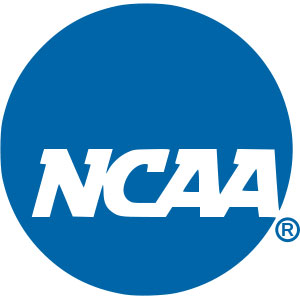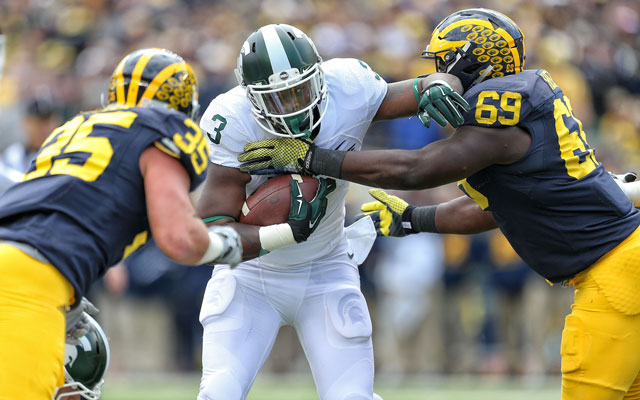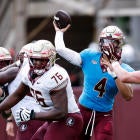I have been a proponent of college football’s targeting rule, which can result in an automatic ejection for a player. But it’s becoming harder to defend the policy since it’s clear that it is far from perfect and changes are needed. When a player gets ejected for being blocked into a quarterback while pushed to the ground, your rule has a serious problem.
The latest example of this rule being a problem came when Michigan linebacker Joe Bolden was tossed last Saturday for targeting, even though it’s difficult to figure out what he could have done differently. Michigan State offensive lineman Jack Conklin was engaged in a block with Bolden, who got pushed to the ground by Conklin after quarterback Connor Cook had slid to end the play. Bolden’s facemask appeared to inadvertently hit Cook’s facemask. The Big Ten's replay official upheld the call and Bolden was ejected.
The Big Ten would not make officiating coordinator Bill Carollo available to comment and referred questions about the targeting rule to national officiating coordinator Rogers Redding. Redding declined to comment specifically about the play and referred those questions to the Big Ten. You know officials missed a call when bureaucrats silently pass the buck around.
One officiating coordinator, who did not want to be identified while criticizing another conference’s officials, said Bolden should not have been ejected. This person believes the issue wasn’t the block knocking Bolden into Cook but rather that there wasn’t enough forceable contact for replay to uphold the call on the field.
Right now, the targeting rule is interpreted as strict liability on the player who does the hitting. In other words, it’s up to the player to avoid hitting someone else in the head. One officiating coordinator speculated that the Big Ten replay official may have felt his hands were tied on the Michigan-Michigan State play because replay’s main job on targeting is to determine whether forcible contact occurred.
Said Redding: “If the cause of him hitting a player is a block, then targeting should not be called. It’s much like roughing the passer. He may be blocked, but it takes a second action to launch himself into the passer. When in question, we’re going to err on the side of safety because players learn they put themselves at risk if they hit somebody high.”
Safety is admirable. Football is a violent and dangerous sport that needs to evolve to maintain its popularity. But there must be a better way than ejecting players on really iffy hits. American Athletic Conference officiating coordinator Terry McAulay has an idea he plans to resubmit after the season to the NCAA Football Rules Committee: Use college basketball’s flagrant foul model.
Under McAulay’s proposal, which had previously been rejected, there would be Flagrant 1 and Flagrant 2 targeting penalties. A Flagrant 1 penalty, as determined by replay, would be for a less egregious and perhaps unintentional high hit. The penalty would be 15 yards and the player would remain in the game unless it’s his second targeting infraction, which would result in an ejection. In other words, Flagrant 1 would give a player the benefit of the doubt. Flagrant 2 would be the current penalty of automatic ejection but only for clear targeting plays.
“We have enough experience now to know the difference,” McAulay said. “I think if we got in a room with a lot of knowledgeable people, we’d be pretty much on the same page on whether it’s a Flagrant 1 or a 2 on a lot of these plays. This is anecdotal, but I think most of the targeting fouls these days appear to be those in that gray area. We’re seeing less launching. We don’t want to put people out unless we’re sure they committed an actual targeting foul as intended.”
McAulay said the targeting penalty has worked to minimize big hits. Coaches are coaching differently. Players are tackling differently. But so much of the current targeting penalty “is not so black and white,” McAulay said. “It is very inconsistent because even when you look at it in replay, it’s often the difference of an inch or so between targeting and a legal hit.”
McAulay knows what the backlash will be from his proposal: The perception the NCAA is backing off player safety. “I don’t think we would be,” he said. “I think we could make this better.”
Something has to be done to provide sanity to a well-intentioned rule. The alternative is more players will get ejected because they made the criminal mistake of getting blocked.
 |
Oliver Luck, Jay Bilas debate
|
|
NCAA vice president Oliver Luck and ESPN analyst Jay Bilas appeared at a debate this week at Texas A&M about whether college athletes should be allowed to be paid. The biggest takeaway: The recent Ninth Circuit Court of Appeals opinion in the Ed O’Bannon case has become the NCAA’s new Board of Regents (the 1984 Supreme Court case the NCAA used for decades to legally defend amateurism). Luck, who once said he thinks college athletes have a constitutional (and then later, a fundamental) right to be paid for use of their names, images and likenesses, followed the NCAA talking points. He cited some key passages in the O’Bannon opinion multiple times. The NCAA is thrilled with the judge's passages that payments to athletes should be tethered to education. Luck argued that allowing athletes to be paid would make it difficult to motivate them for an education. If athletes could market themselves for money, Luck said, “there’s simply no time to do that, particularly an 18- or 19-year-old who’s not necessarily sophisticated in business or promotion.” Said Bilas: “I can tell you right now there are Texas A&M athletes on a plane flying to SEC (basketball) media day so they’ve got the time to promote college athletics when it’s making the enterprise some money. If it’s making themselves some money, we’ve got to stop that. They don’t have time for that.” The most compelling dialogue occurred after Bilas described how revenue continues to increase in the multi-billion-dollar industry without players being allowed to maximize their value. Luck said he’s happy the industry's money increases because it supports many sports teams. Bilas pressed Luck on whether it’s antithetical to what college is about when the money returning to schools gets paid in exorbitant sums to coaches and administrators. Luck acknowledged it’s a “challenge” to justify some of the coaching salaries but added there’s no legal mechanism for an NCAA cap. “It doesn’t change in my mind the rationale because those are adults,” Luck said. “We’re talking about college students age 18 to 22, whatever it may be.” Bilas: “Which most people would call adults.”
It was that kind of debate for Luck, who earlier this year reached out to Sonny Vaccaro -- the architect of the O'Bannon case -- to discuss college sports' future. Due to ongoing litigation, Luck appeared to be toeing the NCAA company line while debating Bilas. Given Luck's past opinions regarding athletes' names, images and likenesses, it was hard to believe even Luck bought into everything he was saying. Even if you disagree with Bilas’ arguments, you’re likely not going to beat him in a debate, especially if you don't believe what you're saying. |
|
 |
Pac-12 lets athletes vote
|
|
The Pac-12 became the first major conference to give college athletes a formal voice in the conference’s governance process. This week at Pac-12 meetings in San Francisco, athletes have one-quarter of their schools’ votes as part of the conference’s one-school, one-vote structure. Athletes joined their athletic directors, senior woman administrators and faculty reps in four-person delegations who vote on conference matters. The new athlete subgroup consists of two athletes per school (a total of 24), with 12 members attending every Pac-12 Council meeting. The athletes come from 17 different sports and 22 different academic majors. Three Pac-12 football players are in the voting structure: Arizona kicker Casey Skowron, Stanford wide receiver Rollins Stallworth and Washington running back Deontae Cooper. The only men’s basketball representative is Oregon State’s Malcolm Duvivier. Until now, Pac-12 athletes had been involved informally in governance decisions, similar to other conferences. NCAA governance now allows each of the 65 schools in the Power Five conferences to have a vote plus 15 athletes -- three from each conference. The Pac-12 went a different route by giving athletes an equal vote at their school along with athletic directors, faculty reps and senior woman administrators instead of making athletes a separate entity for what may have been more of a less-impactful voice. |
|
 |
Judge: Settlement objections likely won't succeed |
|
US District Judge Claudia Wilken wrote that three individuals’ objections to the NCAA and Electronic Arts video game settlements “are not likely to succeed. The Court considered and overruled the objections as meritless when it approved the settlement and its approval of the settlement can only be reversed if the Ninth Circuit finds that the Court abused its discretion.” Wilken issued this opinion on Wednesday while ordering the objectors to post a $5,000 bond as they pursue an appeal with the Ninth Circuit. The Ed O’Bannon and Sam Keller plaintiffs who settled the case had sought an $89,000 bond. Wilken has previously approved the $40 million settlement with EA and Collegiate Licensing Company and the $20 million settlement with the NCAA. The objections have delayed payments going out to current and former football and men's basketball players who filed settlement claims for appearing in past video games. |
|
 |
Read 'em
|
|
* According to ESPN’s John Barr and Jeff Goodman, five former Louisville basketball players and recruits said they attended parties that included strippers paid for by former graduate assistant coach Andre McGee. One former player said he had sex with a dancer after McGee paid her. * Bruce Feldman of FoxSports.com detailed former Ohio State football player Noah Spence’s drug addiction as he resumes his career at Eastern Kentucky. * Police said former Alabama running back Altee Tenpenny showed erratic behavior and fired a gun into the air days before his death, John Talty of AL.com reported. |
|
 |
Quote of the week
|
|
“I don’t know if any of this is true or not. There’s only person who knows the truth, and he needs to come out and tell the truth to his teammates, to the University of Louisville, to his fans and to his coaches that have taught him to do the right thing for years and allowed him to be part of something special here.” -- Louisville coach Rick Pitino on the sex scandal engulfing his basketball program |
|
Follow and read more from Jon Solomon on Facebook and Twitter.





















